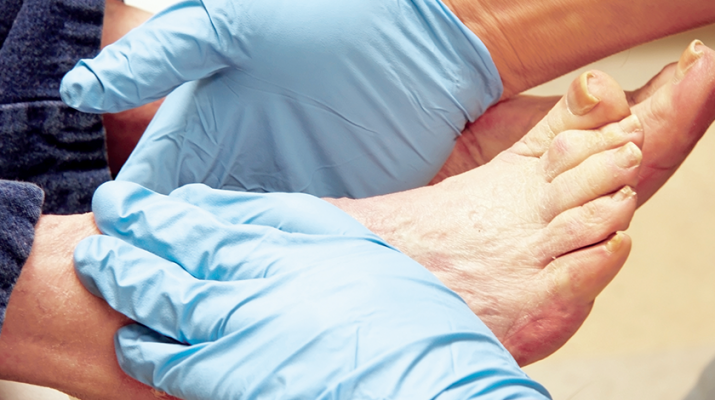Get a leg up on foot problems as you age
By Barbara Pierce

Our feet are the most important part of our body, said Kevin Crable, podiatrist at Oneida Health Podiatry Care.
They’ve carried you everywhere from your first day of school through this morning’s walk. Pretty much everything else about your body has changed, so it’s not surprising that your feet change as you age.
Yes, our feet may be the most important part of our body. If we have a problem, it can change our life. It’s estimated that 90 percent of those over the age of 65 will have some kind of foot problem.
These foot problems can have a serious impact. Because when you can’t walk or can’t walk without pain, it’s difficult to do the activities of daily living. You lose your independence and must depend on others for help.
Also, there could be a significant impact on all other areas of your life — your ability to work or volunteer is limited, your social activities become restricted, and your economic status can be affected.
It’s essential to care about your feet as you age, said Crable.
One thing that happens as we age is the blood flow to our feet slows. “As people age, the blood flow to your lower extremities is compromised,” said Crable.
“Peripheral vascular disease and peripheral arterial disease are prevalent among older adults,” he noted.
These diseases cause foot pain, cramping, and many other foot and ankle problems. When blood flow is lessened, wounds don’t heal. Small foot problems develop into major problems.
People with diabetes especially need to care about their feet, cautioned Crable. One consequence of diabetes is decreased blood flow to the feet. This makes any minor foot problem, like a new shoe blister or stepping on a sharp object, slower to heal.
Combine that with the nerve damage that diabetes often causes and you might not even notice a worsening infection, which can result in an ulcer that won’t heal.
If you have diabetes, see your podiatrist regularly to keep your feet in good shape, just like you see your ophthalmologist for your eyes.
Flat-footed
Another common thing that happens to our feet as we age is we lose the fat on the bottoms of our feet. By the end of the day, we can have pain because we’re walking on bones. The only solution is to wear cushioned, comfortable shoes.
The majority of us will get some arthritis in our feet. There are more than 30 joints in our feet, all of which can degenerate with age.
Besides pain, you might feel stiffness in the morning that improves once you get moving then worsens again at night. Shoe inserts, exercises to increase range of motion, and losing weight if you’re heavy may help, say podiatric experts.
Hip and knee arthritis also have trickle-down effects, altering your alignment in ways that can cause pain on the insides or outsides of your feet. If any of your joints ache, see your doctor. Treating hip and knee arthritis often lightens the load on your feet as well.
Another way aging shows up in our feet is that our toes curl up. And we don’t mean in that in a sexy, between-the-sheets kind of way. Years of stuffing your toes into high heels puts you at risk for hammertoes. What can start as mild discomfort turns more painful over time, and corns and calluses can also crop up as your crooked toes rub against your shoes.
To prevent and ease hammertoes, cover corns and calluses with padding and trade in your pointy-toed heels for shoes with wider toes.
Good news, though — You don’t have to ditch your stilettos completely. If you want to wear them for a night out, wear well-fitting flats or walking or running shoes, if you can, during the day.
The more support you can give your feet, the less inflammation you’ll incur throughout the day, and the better you’ll be able to tolerate a dressier shoe at night, experts say.
Over time, the connective tissue known as ligaments can stretch out, leaving your arch aching and your foot flatter. What’s more, the sensors that typically alert your brain that your ligaments are overstretching —think of them like backup sensors for your joints — start to go on the fritz. This throws you off balance and leaves you prone to a recurring cycle of ankle sprains.
Your skin dries out as you age, leaving your feet prone to cracking. Fight back by making sure you drink plenty of water and use a moisturizer on your legs and feet.

